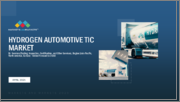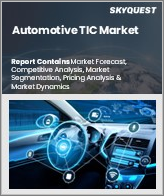
|
시장보고서
상품코드
1570924
자동차 TIC 시장, 기회, 성장 촉진요인, 산업 동향 분석과 예측(2024-2032년)Automotive TIC Market, Opportunity, Growth Drivers, Industry Trend Analysis and Forecast, 2024-2032 |
||||||
세계의 자동차 TIC 시장은 2023년에 212억 달러에 달하며, 2023-2032년 4.8% 이상의 CAGR로 성장할 것으로 예측됩니다.
세계 각국 정부의 엄격한 안전 기준과 규제가 이러한 성장에 힘을 실어주고 있습니다. 규제 당국은 엄격한 안전, 품질, 환경 기준을 적용하고 있으며, 자동차 제조업체는 이를 준수해야 합니다. 여기에는 충돌 안전성, 배기가스 배출, 전자 시스템 신뢰성 테스트도 포함됩니다. 시장 진입을 위해서는 규정 준수가 필수적이며, 규정 위반은 처벌, 리콜, 판매 금지로 이어질 수 있습니다. 이에 따라 제조업체들은 복잡한 규제를 극복하고 필요한 인증을 확보하기 위해 TIC 서비스에 점점 더 의존하고 있으며, 이는 시험, 검사 및 인증 서비스에 대한 안정적인 수요를 보장하고 있습니다.
이 시장은 조달처에 따라 자체 서비스와 아웃소싱 서비스로 구분되며, 2023년에는 아웃소싱 부문이 시장 점유율의 67% 이상을 차지하고 2032년에는 220억 달러 이상에 달할 것으로 예측됩니다. 자동차 기술의 복잡성과 규제 요건의 강화로 인해 아웃소싱 서비스가 주류로 부상하고 있습니다. 자동차 기업은 종합적인 시험, 검사, 인증에 필요한 전문 지식과 인프라를 갖추지 못한 경우가 많기 때문에 제3의 전문가를 고용하는 것이 비용 효율적입니다. 제3자 기관은 규제 변화와 시장 수요에 빠르게 대응할 수 있으며, 사내 역량에 비해 더 효율적이고 유연한 솔루션을 제공할 수 있습니다.
차량별로 보면 시장은 상용차와 승용차로 나뉘며, 2023년에는 승용차 부문이 약 65% 시장 점유율을 차지할 것으로 예상됩니다. 이 부문은 전 세계 자동차 보유 대수에서 차지하는 비중이 크고 TIC 서비스에 대한 수요가 높기 때문에 자동차 TIC 시장을 주도하고 있습니다. 전 세계에서 엄격한 안전 및 배기가스 규제로 인해 철저한 테스트와 인증이 필요하며, ADAS, 텔레매틱스 등 첨단 기술이 탑재된 최신 승용차는 복잡하므로 전문적인 테스트와 검사가 필요합니다. 전기자동차(EV)의 보급이 확대되고 새로운 부품에 대한 인증의 필요성이 높아짐에 따라 승용차 TIC 시장의 우위가 높아지고 있습니다.
2023년에는 아시아태평양이 시장 점유율의 42% 이상을 차지할 것으로 예상되며, 2032년에는 143억 달러 이상에 달할 것으로 전망됩니다. 이 지역은 중국, 일본, 한국, 인도와 같은 자동차 강국의 본거지로서 자동차 TIC 시장에 큰 영향을 미치고 있습니다. 급속한 도시화와 가처분 소득 증가로 자동차 소유율이 높아지면서 TIC 서비스에 대한 수요가 증가하고 있습니다. 특히 중국과 인도에서는 정부가 안전 및 배기가스 규제를 강화하면서 시장 성장을 더욱 촉진하고 있습니다. 주요 자동차 제조업체의 존재와 소비자 선호도 변화도 시장 확대에 기여하고 있습니다.
목차
제1장 조사 방법과 조사 범위
제2장 개요
제3장 업계 인사이트
- 에코시스템 분석
- 공급업체 상황
- 자동차 제조업체(OEM)
- Tier 1 및 Tier 2 공급업체
- 독립계 TIC 프로바이더
- 규제기관 및 표준화 단체
- 기술·설비 공급업체
- 이익률 분석
- 기술과 혁신 전망
- 특허 분석
- 주요 뉴스와 구상
- 규제 상황
- 영향요인
- 촉진요인
- 세계 각국 정부에 의한 엄격한 안전기준과 규제
- 자동차 안전성에 대한 소비자 의식의 향상
- 커넥티드카 기술 및 전기자동차에서 기술 진보의 증가
- 세계의 자동차 생산 대수 성장
- 업계의 잠재적 리스크 & 과제
- 첨단시험 기기나 설비에 대한 높은 투자 비용
- 숙련 노동자의 부족
- 촉진요인
- 성장 가능성 분석
- Porter의 산업 분석
- PESTEL 분석
제4장 경쟁 구도
- 서론
- 기업 점유율 분석
- 경쟁 포지셔닝 매트릭스
- 전략 전망 매트릭스
제5장 시장 추산·예측 : 서비스별, 2021-2032년
- 주요 동향
- 검사
- 검사
- 인증
- 기타
제6장 시장 추산·예측 : 조달별, 2021-2032년
- 주요 동향
- 사내
- 아웃소싱
제7장 시장 추산·예측 : 차량별, 2021-2032년
- 주요 동향
- 승용차
- 상용차
제8장 시장 추산·예측 : 용도별, 2021-2032년
- 주요 동향
- 자동차 검사
- 배출 가스 검사
- 컴포넌트 검사
- 텔레매틱스
- ADAS
- 인정 시험
- 연료, 유체, 윤활유
- 전기 시스템 및 컴포넌트
- 기타
제9장 시장 추산·예측 : 지역별, 2021-2032년
- 주요 동향
- 북미
- 미국
- 캐나다
- 유럽
- 영국
- 독일
- 프랑스
- 스페인
- 이탈리아
- 러시아
- 북유럽
- 기타 유럽
- 아시아태평양
- 중국
- 인도
- 일본
- 한국
- 뉴질랜드
- 동남아시아
- 기타 아시아태평양
- 라틴아메리카
- 브라질
- 멕시코
- 아르헨티나
- 기타 라틴아메리카
- 중동 및 아프리카
- UAE
- 남아프리카공화국
- 사우디아라비아
- 기타 중동 및 아프리카
제10장 기업 개요
- ALS Limited
- Applus+
- Bureau Veritas
- Cotecna Inspection S.A.
- DEKRA SE
- DNV GL
- Element Materials Technology
- Eurofins Scientific
- Exova Group plc
- Intertek Group plc
- Kiwa Group
- LEONI AG
- Lloyd's Register Group
- MISTRAS Group, Inc.
- RINA S.p.A.
- SGS Group
- TUV NORD Group
- TUV Rheinland Group
- TUV SUD Group
- UL LLC(Underwriters Laboratories)
The Global Automotive TIC Market was valued at USD 21.2 billion in 2023 and is projected to grow at a CAGR of over 4.8% from 2023 to 2032. Stringent safety standards and regulations imposed by governments worldwide drive this growth. Regulatory bodies enforce rigorous safety, quality, and environmental standards, compelling automotive manufacturers to comply. This includes testing for crashworthiness, emissions, and electronic system reliability. Compliance is mandatory for market entry, and non-compliance can result in penalties, recalls, or bans. Consequently, manufacturers increasingly rely on TIC services to navigate complex regulations and secure necessary certifications, ensuring consistent demand for testing, inspection, and certification services.
The overall automotive TIC industry is classified based on the service, sourcing, vehicle, application, and region.
Based on sourcing, the market is segmented into in-house and outsourced services. In 2023, the outsourced segment accounted for over 67% of the market share and is expected to exceed USD 22 billion by 2032. Outsourced services dominate due to the increasing complexity of automotive technologies and stringent regulatory requirements. Automotive companies often lack the specialized expertise and infrastructure needed for comprehensive testing, inspection, and certification, making it cost-effective to engage third-party experts. They can quickly adapt to regulatory changes and market demands, offering a more efficient and flexible solution compared to in-house capabilities.
Based on vehicles, the market is divided into commercial vehicles and passenger cars. In 2023, the passenger cars segment held around 65% market share. This segment leads the automotive TIC market due to its substantial share of the global vehicle fleet, which increases the demand for TIC services. Stringent safety and emissions regulations worldwide necessitate thorough testing and certification for compliance. The complexity of modern passenger cars, equipped with advanced technologies such as ADAS and telematics, requires specialized testing and inspection. The growing adoption of electric vehicles (EVs) and the need for certification of new components enhance the passenger cars TIC market dominance.
In 2023, the Asia Pacific region accounted for over 42% of the market share and is expected to exceed USD 14.3 billion by 2032. This region, home to automotive giants such as China, Japan, South Korea, and India, significantly influences the automotive TIC market. Rapid urbanization and rising disposable incomes have increased vehicle ownership, driving the demand for TIC services. Government-enforced safety and emission regulations, particularly in China and India, further stimulate market growth. The presence of key automotive players and evolving consumer preferences also contribute to the market's expansion.
Table of Contents
Chapter 1 Methodology and Scope
- 1.1 Research design
- 1.1.1 Research approach
- 1.1.2 Data collection methods
- 1.2 Base estimates and calculations
- 1.2.1 Base year calculation
- 1.2.2 Key trends for market estimates
- 1.3 Forecast model
- 1.4 Primary research and validation
- 1.4.1 Primary sources
- 1.4.2 Data mining sources
- 1.5 Market definitions
Chapter 2 Executive Summary
- 2.1 Industry 360° synopsis, 2021 - 2032
Chapter 3 Industry Insights
- 3.1 Industry ecosystem analysis
- 3.2 Supplier landscape
- 3.2.1 Automotive manufacturers (OEMs)
- 3.2.2 Tier-1 and tier-2 suppliers
- 3.2.3 Independent TIC providers
- 3.2.4 Regulatory bodies and standards organizations
- 3.2.5 Technology and equipment suppliers
- 3.3 Profit margin analysis
- 3.4 Technology and innovation landscape
- 3.5 Patent analysis
- 3.6 Key news and initiatives
- 3.7 Regulatory landscape
- 3.8 Impact forces
- 3.8.1 Growth drivers
- 3.8.1.1 Stringent safety standards and regulations imposed by governments worldwide
- 3.8.1.2 Growing consumer awareness about vehicle safety
- 3.8.1.3 Rising technological advancements in connected car technologies and electric vehicles
- 3.8.1.4 Global automotive production growth
- 3.8.2 Industry pitfalls and challenges
- 3.8.2.1 High investment costs of advanced testing equipment and facilities
- 3.8.2.2 Skilled labor shortage
- 3.8.1 Growth drivers
- 3.9 Growth potential analysis
- 3.10 Porter's analysis
- 3.11 PESTEL analysis
Chapter 4 Competitive Landscape, 2023
- 4.1 Introduction
- 4.2 Company market share analysis
- 4.3 Competitive positioning matrix
- 4.4 Strategic outlook matrix
Chapter 5 Market Estimates and Forecast, By Service, 2021 - 2032 ($Bn)
- 5.1 Key trends
- 5.2 Testing
- 5.3 Inspection
- 5.4 Certification
- 5.5 Others
Chapter 6 Market Estimates and Forecast, By Sourcing, 2021 - 2032 ($Bn)
- 6.1 Key trends
- 6.2 In-house
- 6.3 Outsourced
Chapter 7 Market Estimates and Forecast, By Vehicle, 2021 - 2032 ($Bn)
- 7.1 Key trends
- 7.2 Passenger cars
- 7.3 Commercial vehicles
Chapter 8 Market Estimates and Forecast, By Application, 2021 - 2032 ($Bn)
- 8.1 Key trends
- 8.2 Vehicle inspection
- 8.3 Emission testing
- 8.4 Component testing
- 8.5 Telematics
- 8.6 ADAS
- 8.7 Homologation testing
- 8.8 Fuels, fluids and lubricants
- 8.9 Electric systems and components
- 8.10 Others
Chapter 9 Market Estimates and Forecast, By Region, 2021 - 2032 ($Bn)
- 9.1 Key trends
- 9.2 North America
- 9.2.1 U.S.
- 9.2.2 Canada
- 9.3 Europe
- 9.3.1 UK
- 9.3.2 Germany
- 9.3.3 France
- 9.3.4 Spain
- 9.3.5 Italy
- 9.3.6 Russia
- 9.3.7 Nordics
- 9.3.8 Rest of Europe
- 9.4 Asia Pacific
- 9.4.1 China
- 9.4.2 India
- 9.4.3 Japan
- 9.4.4 South Korea
- 9.4.5 ANZ
- 9.4.6 Southeast Asia
- 9.4.7 Rest of Asia Pacific
- 9.5 Latin America
- 9.5.1 Brazil
- 9.5.2 Mexico
- 9.5.3 Argentina
- 9.5.4 Rest of Latin America
- 9.6 MEA
- 9.6.1 UAE
- 9.6.2 South Africa
- 9.6.3 Saudi Arabia
- 9.6.4 Rest of MEA
Chapter 10 Company Profiles
- 10.1 ALS Limited
- 10.2 Applus+
- 10.3 Bureau Veritas
- 10.4 Cotecna Inspection S.A.
- 10.5 DEKRA SE
- 10.6 DNV GL
- 10.7 Element Materials Technology
- 10.8 Eurofins Scientific
- 10.9 Exova Group plc
- 10.10 Intertek Group plc
- 10.11 Kiwa Group
- 10.12 LEONI AG
- 10.13 Lloyd's Register Group
- 10.14 MISTRAS Group, Inc.
- 10.15 RINA S.p.A.
- 10.16 SGS Group
- 10.17 TUV NORD Group
- 10.18 TUV Rheinland Group
- 10.19 TUV SUD Group
- 10.20 UL LLC (Underwriters Laboratories)



















